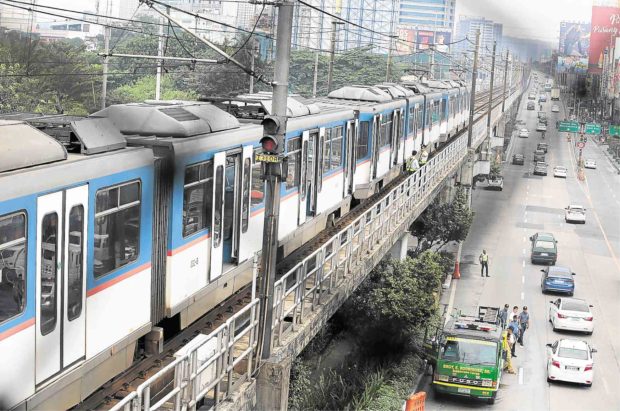Number of MRT 3 trains in operation finally reaches 11

Metro Rail Transit 3 management hopes breakdowns will be a thing of the past after spare parts start arriving.—GRIG C. MONTEGRANDE
For the first time in almost two months, the Metro Rail Transit 3 (MRT 3) managed to deploy 11 trains to ferry close to 300,000 commuters who still rely on the train system despite its sorry state.
At around 5:30 p.m. on Thursday, the MRT 3 management was able to roll out an 11th train, which helped reduce headway to around eight minutes.
Shortly after noon on Friday, the number of operational trains at the country’s main rail line remained at 11.
The last time the MRT 3 had this number of trains in operation was on Jan. 29. Since then, the number of working trains had steadily declined to as low as six trains.
Spare parts
The MRT 3 management attributed the improvement in service to the delivery of the needed spare parts, which the government procured late last year.
Still, the number of operating trains is far from the ideal 15 trains that the Department of Transportation (DOTr) had committed when it took over in November last year as the interim maintenance provider of the MRT 3.
Earlier, Transportation Secretary Arthur Tugade assured passengers there would be 15 trains in operation once they had completed extensive maintenance works on the MRT 3 during the Holy Week break.
Normally, the MRT 3 suspends operations on Maundy Thursday. But for this year, given the current state of the train system and the scope of work needed to be done, the temporary closure of the MRT 3 will begin on Holy Wednesday up to Easter Sunday.
Since the start of the month, there have been only four unloading incidents.
Unloading incidents
In February, nine unloading incidents and two service interruptions were recorded.
Ridership at the MRT 3 is also steadily recovering. From an average of 281,000 passengers last week, the train line saw an average of 290,000 passengers this week.
However, this is still way below last year’s daily average of 463,000 passengers.
The MRT 3 is expected to cater to more passengers once the 48 Dalian trains purchased by the Aquino administration finally roll out.
The DOTr, however, has yet to come out with a timeline when this would be possible, especially after independent audit firm TUV Rheinland told the agency earlier this week that more tests would still have to be done on the Chinese-made trains.
One of those tests includes the trains’ weight. The DOTr said the test was needed since “the previous project team failed to attend and witness the weight testing done in Dalian, China, in November 2015.”
“[T]he weighing test should be done to eliminate any doubts, and so DOTr MRT 3 can witness and formally sign off on the trains’ weight,” the DOTr said.